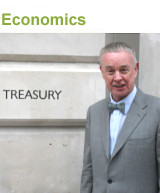Click here to download as a PDF document
The important fact to understand about the Anglo-Saxon model of capitalism is that it did not arise by chance. Instead it was the product of the culture from which it emerged, and developed with the characteristics and the style of the people who produced it. In particular, it incorporates two philosophical stands which run deep within the Anglo-Saxon culture.
I must at this point make it clear that although the descriptive word is Anglo-Saxon, I include the Celtic peoples of the United Kingdom. Indeed, as a Scot myself and a countryman of Adam Smith, I could hardly help noting how readily the Scots have taken to this model of capitalism, and how successful they have been in using it to advantage.
The first of these two philosophical stands which form the basic principles of this model is the adversarial principle. Central to the British philosophical style has been the notion of conflict. In our laws courts we set one side to put the whole case for the prosecution, and face them by another side making the whole case for the defence. The supposition is that an impartial jury will be more likely to discern the truth of the matter from this clash of opposites, than by any joint enquiry of experts such as might be favoured in other countries.
The British parliamentary system incorporates the same principle. Our two sides face each other; they do not sit around the continuous shape of a crescent. They sit or stand the distance of two sword lengths apart, so that the combat will be ritual and verbal; but combat it is. We do not often form coalitions. Our electoral system is non-proportional so that it usually produces a clear winner to govern and an opposition to oppose everything.
The adversarial principle underlies our philosophy of science. We pit the rival theories against each other in the ritual combat of scientific experiment. That which more successfully predicts the observed outcome is declared the winner until it faces a new challenger. It is through these ritual combats that new theories replace the old and that scientific progress is made.
The strength of the adversarial principle in Britain helps to explain some of the difficulties we face in being a good partner in the European Union. What is mere harmonization to other countries with their similar outlook can run completely counter to the British tradition of law, government and philosophical approach. To understand the British outlook, think of the way in which a biological organism either has the gene or it does not; there are no averages: or the way in which a computer gate is open or closed, without intermediate positions.
The adversarial principle lies behind our model of capitalism. It is essentially competitive. One group vies with others for supremacy. The market is a battle-field in which ritualized combat takes place. Just as a litigant loses a lawsuit, a party loses an election, and a theory is discarded by scientists, so is a commercial enterprise defeated in a contest against rivals. It is foreign to the Anglo-Saxon model to suppose that a whole people will best improve their economy and generate wealth by working together collectively for the common good. They do it instead by competing against each other for the good of themselves.
It affords great satisfaction to those of us imbued with this adversarial principle to note that in the greatest battle of the Twentieth Century, it was the collectivist model which was finally counted out, and the competitive system which prevailed against it after decades of epic struggle.
The second of the two great principles which underlie the Anglo-Saxon philosophy is the evolutionary principle. It is a theory of change and an approach to it. Put at its simplest, the theory says that change is not best accomplished by sudden and violent disruptions which overthrow the status quo, but by a process which allows continual modifications to be made and incorporated. This requires a system tolerant enough to admit of variation and change, and flexible enough to weave those changes into the thread of current practice. The result is to change one state of affairs into another by a series of intermediate steps, some of them almost imperceptible, but which cumulatively build up the new reality. It is a very different process to one characterized by discrete jumps.
Just as in biological evolution, the process of modification in social and economic affairs can take place faster at some times than at others. But the essential basis of the evolutionary principle is the accumulation of small changes which gradually transform the status quo.
The British had no French Revolution, nor its equivalent. The monarchy gradually became a constitutional one. Parliament emerged over many centuries. There was no sudden declaration of the Rights of Man to change the status of the citizen; the British Bill of Rights is made up of legislation passed in different eras. English law has been built up and modified on the basis of successive cases, not by periodic codification. All of this shows how deeply the evolutionary principle penetrates the culture and psyche of the nation. Like the adversarial principle, it is an important source behind the Anglo-Saxon model of capitalism.
I regard it as one of the lost opportunities of history that Karl Marx, despite brilliant historical insights, opted for the Hegelian theory of change. He was a contemporary of Darwin, and applauded the view that humans descended from animals, but he failed to see the significance of the evolutionary theory of change, and how it might be applied to the economy and to society.
These two principles, the adversarial and the evolutionary, go a long way to explain why the Anglo-Saxon model of capitalism resists tendencies to restrict competition within it, and resists the tendencies which might make it less flexible and adaptable. It must allow for adversarial conflict by maximizing the opportunities for ritualized combat in the form of competition. It must also allow for innovations to be introduced, to prove what merit they have, and to be incorporated, if successful, into a new status quo.
When we look over the attributes of the Anglo-Saxon model of capitalism, armed with these twin insights, we can see why it comes to have the characteristics which distinguish it from other models, and which give it a distinctive identity. Its approach always is to maintain competition where it can, and to keep its operation flexible. The two principles keep its outcome spontaneous and unplanned.
Investment
Broadly speaking, this model, which I will call for shortness the competitive model, allows enterprises seeking investment to compete against each other for the available funds. It is an aberration when it tends to favour some forms of investment over others. The government of Harold Wilson from 1964-70 introduced a Selective Employment Tax to encourage investment in manufacturing at the expense of service industries. This was quickly repealed precisely because it attempted to direct what should be a spontaneous movement. Typical of so many governments, it looked to where the market was going, and tried to stop it.
Because governments should not attempt to force investment into domestic locations, the competitive model does not restrict its citizens from investing in other countries, or restrict foreigners from investing in its own country. One of the first acts of the Thatcher administration was to abolish exchange controls. Foreign investment should be able to compete with domestic funds, and foreign enterprises should be able to compete for funds against domestic ones. In this way the adversarial principle is given maximum play.
The use of tax concessions to funnel investment into locations preferred by government runs counter to the principles of this model. In an ideal world it should be left to investors to decide where the best balance of returns against risk is to be found. In the real world governments intervene to make their own bonds more attractive with unequal tax advantages. Sometimes they intervene to direct investment toward industries which they think represent the economic future of their country. Under the competitive model government has no such knowledge, and should not be giving some enterprises a non-competitive investment advantage. The record of British governments which tried to pick economic winners is not a good one. They merely misdirected investment.
Tariffs & trade
Many governments take a similarly nationalistic attitude to their own products, interfering with competition by the use of trade barriers or tariffs. The aim is to increase the price of foreign goods, or reduce their supply, so that people will be denied the choice they would have made. Again, the competitive model is much less inclined to favour tariff or trade walls than its rivals. Free trade has been the watchword, in the belief that free competition will probably direct resources toward efficient producers, leaving the surplus resources free to be directed into other activities.
The aim of the Common Agricultural Policy of the European Union is to force domestic customers to pay higher prices than they need to for food, to deny markets to those who can produce food more cheaply, and to direct into agriculture much of the investment which could be creating new jobs and new growth in industry. A competitive model economy would follow the Theory of Comparative Advantage inspired by Adam Smith, buying the cheap foreign goods and using the resources thus released to invest in what it could do more efficiently itself.
When countries are forced into agreements to lower tariffs, some of their governments respond by substituting non-tariff barriers. There may be no punitive tariffs on US goods in Japan, but they face insurmountable hurdles before they can comply with regulations designed to favour domestic products at their expense. French specifications on solid waste disposal trucks, German rules relating to the manufacture of lawnmowers, and the restrictions on bicycles in the Netherlands are all examples from closer to home of the use of non-tariff barriers to restrict competition. They run counter to the precepts of the competitive model.
Labour markets
It is in the flexibility of labour markets that the competitive model displays its distinctive characteristics. Because the evolutionary principle needs flexibility and adaptability, competitive model economies try to keep their labour markets as dynamic as possible. Instead of seeking to maintain the job levels in any existing sectors of industry, they seek the conditions which allow labour to contract in some areas and expand in others. They seek to remove the downward stickiness of employment levels.
It is generally easier in the competitive model to lay off workers, to employ part-time workers, or to impose involuntary early retirement. Many economic models impose costs upon these activities in the name of protecting the rights of workers. They make it expensive for a manufacturer to reduce the employment roll during an economic downturn. The competitive model sees this as a restriction on flexibility, a way of preventing the demise of some industries and the rise of others. These costs act as a brake on the process of economic evolution.
If the competitive model seeks to protect workers from the process of economic change, it will try to do so in ways which promote flexibility rather than in ways which diminish it. It might help workers to relocate, to apply for the new jobs, to re-train for them. It might facilitate the institutions and instruments to look after them and speed them through the transition. What it will not generally do is to force employers to keep them in the old jobs.
It is crucial to a dynamic, competitive economy that labour as well as capital is constantly being recycled, moved from yesterday’s declining industries into tomorrow’s expanding ones. This is one reason why such an economy must look with ambivalence and skepticism at the activities of trade unions. Unions themselves are usually a strong force acting against mobility in labour markets. On the whole they seek to benefit their members at the expense of non-members.
All things being equal, unions make it more expensive to install labour-saving machinery or to operate labour-saving practices. They impose conditions which restrict the ability of outsiders to compete, and they limit the range and variety of duties which their members will undertake. All of these are important restraints on the flexibility of labour markets; which is why governments of the competitive model normally act to limit the powers of unions.
Social costs
Competitive economies are always watchful of the social costs of employment precisely because they make labour markets less flexible. The more which it costs to employ a person, the less likely it is that the person will be employed. Even in economic upturns, a firm is less likely to take on new labour if huge costs are added to the activity, and especially if the firm is then locked into those costs even after the upturn has run its course.
The social costs of employment in the European Union make labour twice as expensive at some levels as the actual wages paid. The addition of compulsory insurance, sick leave, maternity leave, paternity leave, statutory holidays, pension costs and redundancy costs all add to the burden and reduce flexibility. While it seems inevitable in an advanced economy that a balance must be struck, the competitive model will seeks a balance which allows for more flexibility.
Britain notoriously reserved an opt-out from the Social Chapter of the Maastricht Treaty, believing that its national interest requires labour markets more flexible than those which the Social Chapter would impose. A crucial part of Britain’s case for doing so concerns the effect which social costs have on new industries. It is not just that existing industries are made less able to compete with foreign rivals if high labour costs are imposed. It is also that new businesses which could be starting up to occupy new economic niches are unable to do so because of the high labour costs which social policies impose upon them.
Critics who dismiss this position as one which seeks low-wage jobs and poor social protection miss the point. The point is that only an adaptable economy can create and nurture the jobs on which future national wealth will depend. Only a wealthy country with viable and competitive industries will be able to afford the social and public services which it deems appropriate. The Social Chapter is unacceptable to the Anglo-Saxon model because it simultaneously opposes both of the principles which underlie that model. It makes industries uncompetitive and it makes the economy less able to evolve.
It is revealing that several large British firms have declared themselves prepared to implement most of the requirements of the Social Chapter. It is revealing because it is predictable. Anything which acts to limit competition and flexibility acts in favour of the status quo. Large and successful firms naturally find it in their own interests to limit the ability of other, newer firms to rise and challenge their established position. Social costs fall selectively harder on the smaller and newer businesses.
Minimum wage
Adherents of the competitive model are in no doubt that statutory minimum wages act against it. If other things remain the same, an increase in the price of any product will generally lower the demand for it, and this is as true of labour as for other inputs. Some jobs are just worth doing at one wage, but not worth doing at another. If the wage is raised, it might become cheaper to employ machines, or to dispense with the job altogether.
The point about low-paid jobs is that they are the first step on the ladder. They provide economic opportunity, particularly to the unskilled, the young and ethnic minorities. The low wage which they will work for gives them economic advantage. They can bid for jobs they would not get in any other way. Any the low-paid job often affords the on-the-job training and work experience which enables them to move up the economic ladder. If that first rung is denied to them by minimum wage legislation, they never make that economic climb.
The shock research from the US studies by Card, Katz and Kreuger appeared to show that increases in minimum wage at state levels did not cause job losses. This emboldened those in the British Labour Party committed to minimum wages, but the research was not borne out by subsequent studies which faulted the methodology and contradicted the findings. Indeed, the lesson from the USA is clear and unambiguous: increases in federal minimum wage levels cause unemployment to rise selectively among the vulnerable groups, including teenagers and non-whites.
Put at its crudest, minimum wage legislation is designed to prevent competition from those who would work for lower wages. It aims to close off competition at the bottom end of the labour market, and its principal effect is to prevent the development of new jobs which could make effective use of that labour. Minimum wages, like imposed social costs, are just another way of intervening in the competitive process in order to stop it from operating effectively.
Welfare
Welfare policy in the advanced economies is rapidly becoming the biggest single obstacle to competitive and evolving economies. It imposes costs, it destroys incentives, and it severely restricts the ability of economies to adapt and change.
The cost of welfare is immense. In the United Kingdom it accounts for roughly one third of all government spending, and imposes an immense tax burden on the economy. The most recent calculations show that the welfare budget in Britain costs every working person £15 for every working day. This is a huge sum, and diverts the funds which they could otherwise put to consumption and investment.
Of no less significance is the effect which welfare policies have on labour market rigidity. Welfare provides in effect an alternative to low paid employment, and helps to price low paid jobs out of the market. The incentive which leads people to seek personal advancement can be destroyed by welfare policies which withdraw state help in exact proportion to self help. If a person works longer hours at a hard job and draws no more money than could be gained by living on welfare, we should hardly be surprised when many make the alternative choice.
There seems to be an economic trend to give countries the long term unemployment they pay for. Countries whose welfare programmes allow unemployed people to draw welfare indefinitely are the same countries which have high rates of long-term unemployment. Those countries which cut benefits off after a limited period have much less of a problem.
There are several reasons behind this, but the chief one is that unlimited welfare extends the option of sitting at home and drawing benefit. Given the possibility of an unpleasant job as a bus conductor, getting up early, standing all day, dealing with awkward customers, a person might decline the job if the state allowed him or her to remain at home on virtually the same money. If the state withdrew that option, they would have to take the job, and perhaps advance from it into a better job. Once again, the statistics are clear: it is easier to move from a poor job into a better job than it is to move from no job into a job. Those same statistics tell us that in Britain, for example, a person unemployed for a year stands a less than 5% chance of gaining a job within three months.
If welfare offers an alternative to employment, it undermines the competitiveness of the low paid jobs. Indeed, to the extent that it is an alternative, it forces up the price of low paid jobs, or, like the minimum wage, forces them out of existence. A modern, generous and compassionate society naturally wishes to ensure for all of its citizens an acceptable standard of living. What it has to consider, however, is that if it makes this too easy or to comfortable to obtain from the state, people will cease the effort to obtain it for themselves. To decline to work for that which is freely available is a rational choice. It is a testament to the desire for self-reliance that it is not made by even greater numbers.
The underclass of the long term unemployed and those lacking in any work skills or experience is not helped by welfare. Indeed, it is a product of state welfare and is sustained by it. Welfare effectively takes the bottom group out of the labour market altogether, with all that this implies. It is one thing to have an unemployment policy to speed those displaced back into productive work. It is quite another to have a welfare policy which keeps them permanently outside of the productive economy.
Regulation
An evolving economy needs to have a high start-up rate of new businesses. That not all of these will survive is unimportant. What is important is that new ones should start, and that on balance there are enough new ones to outweigh any job losses caused by decline in the established industries. The new businesses introduce new products and processes; they apply new methods to organization, production and marketing; they exploit new market niches. Just as biological evolution is driven by a selective death rate among the least equipped to survive, so does an economy evolve by constantly discarding those least able to survive the judgement of consumers and investors.
One of the largest obstacles to the evolutionary principle is the burden of regulation. The political masters of a society act through its bureaucracy to regulate business and industry, over-riding the judgement which consumers might make by denying them access to some of the products which they might otherwise buy. As with other interference by government, a balance must be struck. No-one wants unsafe goods on the market, or products which are not what they purport to be. What burdens industry and restricts new entry is the crushing burden of detail imposed by rule-givers, most of whom have not the slightest understanding of the industry they oversee.
The competitive model capitalism seeks to restrict regulation to the minimum. It recognizes that what passes for the maintenance of standards is often little more than the use of legislative power by established industries to keep competitors from entering the field with alternatives. We require that our doctors be qualified, and that they undergo a lengthy period of training. When we begin to demand the same of hairdressers and cab drivers, it begins to seem more helpful to established hairdressers and cab drivers than it does to their customers. By restricting entry it enables higher prices to be charged.
Regulation is inherently anti-competitive, and in competitive model economies it is up to those who would regulate to prove that the gains of regulation justify this adverse effect. We ask two questions of the regulator: How far does this requirement interfere with the competition required by the adversarial principle? How far does it act to limit the economic adaptability and progress required by the evolutionary principle? If the answers outweigh any conceivable good which it could do, the competitive model would make the presumption against it. The rule of caveat emptor is by no means universal, but it does count as a factor to be borne in mind. Some people might want to buy inferior products because they are cheaper. They might want lower quality meat because that is all they can afford.
In general, the more detailed the regulation, the greater are the costs of compliance, and the more it restricts the development of alternatives. Consider, for a moment, the common approach to the emission of noxious fumes. Overwhelmingly the approach has been process driven. That is, governments have sought, through their regulators to tell engine manufacturers what technology they must use to curb pollution. They have stipulated catalytic converters in some cases. This closes off the development of alternative and economically more efficient ways of achieving the desired objectives. If the regulations simply specified the amount of noxious output which would be tolerated, manufacturers would have an incentive to develop cleverer and cheaper ways of achieving those goals. This is result driven regulation, and is far less restrictive of competition and economic development.
It is from within the competitive model economies that the notion of market environmentalism has emerged. The idea that economic activity should be restrained in order to protect a reasonably safe and pleasant environment is an acceptable one, but there has to be consideration of cost-effectiveness. Market solutions are those which seek to ally themselves with the innovative and competitive tendencies of economic operators. They create conditions in which economic advantage might be gained by following desirable environmental ends, and direct inventive and entrepreneurial abilities toward finding new and more efficient solutions.
State involvement
In the Anglo-Saxon model of capitalism the state is viewed with skepticism when it takes on the role of economic participant. On this model it lacks legitimacy. It should be keeping the rules to maintain competitiveness and adaptability, not entering as a player and participant. The state should not own businesses or invest in them. It should not enter into the production of goods and services, and should certainly not use its power to compete with private citizens who do so.
Of necessity, the state has to pre-empt some of the resources of its citizens in order to fund its essential services such as military defence and the administration of civil justice. But the state should not use its power to direct people to consume some goods and services rather than others, or to use the compulsion of taxation to direct investment into areas where it would not willingly have gone. It should not subsidize the manufacture of automobiles within its borders, or the operations of its own airline. This type of activity represents a quite illegitimate transfer of resources from the successful and resourceful toward industries and activities which are not.
Even the notion of economic targets sits ill with the competitive model. It asks why the state should be deciding the economic priorities, and why not its citizens? Every act taken by the state usurps a part of the economy open to the play of its citizens. Every intervention undermines competitiveness and adaptability. The ability of an economy to react to circumstances and to change accordingly is inhibited whenever the state forecloses an area for itself and its own operations.
This does not mean or suggest the absence of state activity. What it does imply is that the presumption must be against it in the absence of compelling reason to the contrary. The state has the power to intervene, to buy and sell industries and to establish new ones. There must be very good reasons indeed, however, before it can be considered legitimate for it to do so. And there will be negative effects, some unseen and unknown, to set against any good that is achieved.
The competitive model began to reassert itself from 1979, after decades in which it appeared to have lost its conviction. In Britain and the United States there was a transfer away from the state to the private domain. In Britain this took the form of large-scale privatization, with the actual transfer of state businesses into private hands, a policy so successful that it is now being implemented in more than 100 countries.
High tax rates were cut back, and a start was made in lowering the burden of regulation. In short, many of the basic elements of the competitive model were reasserted and restored. Those who had supposed that the Anglo-Saxon model of capitalism had lost its vitality and relevance were surprised at the huge economic advances which its return facilitated. Indeed, it would not be over-stating the case to say that in the 1980s the world rediscovered the themes of competitive capitalism. Words such as ‘incentive’ and ‘opportunity’ returned into vogue, and many countries abandoned their belief that the economy must be led by the state rather than by the enterprise of its citizens.
Competitive model characteristics
If we look, then, at the central features of the Anglo-Saxon model of capitalism, the view is of a dynamic activity, constantly moving, constantly changing. There are no fixed states to be studied, no equilibrium points. The defining characteristics are those of a process, not of a given state of affairs, or even of a steady state. The principles which distinguish it, the adversarial and the evolutionary principle, give it an unpredictable outcome.
It is not a model into which go government inputs in order to elicit desired outcomes. Nor is it one in which people decide collectively through their governments how many resources shall be allocated to the production of goods and services of different types. The outcomes of the model emerge spontaneously from the interaction of its participants. Planning is done not at the centre by the few, but at the periphery by the many.
While it is essentially adversarial, the struggle between its competing components is confined by the rules of the market. It is formal; its aggression is controlled and restrained. There are limits imposed by custom and by law on how far that struggle may be taken. And while it is essentially evolutionary, it is not the participants themselves who die, but the economic ideas they represent. The individuals can be redeployed, reassigned, or come forward with new economic ideas. The biological world is less kind to its failures; for there it is the individual which dies with its mutation. In the economic world we have institutions like limited liability and bankruptcy to ensure that while the economic idea may be counted out, its proponent can survive to try again.
Finally the question must be asked: How far does the Anglo-Saxon model, called here the competitive model of capitalism, represent any actual economies in the real world? The answer is, as so often when we move from theory to practice, to a degree. As a theoretical construct we can inspect the principles and forces which sustain it. When we look at real economies, they are inevitably corrupted by accumulated tradition, by political interference, and by the understandable but vain desire of people to exercise total control over their own destiny.
As a model it is only an ideal; but its principles and the characteristics which they produce enable others to understand its basic features, and to appreciate why the real economies based upon it act as they do. Britain’s negotiating position, for example, on international economic pacts and treaties, is much more readily understood if the observer understands the principles which distinguish its economic model.
The question of how successful this model will be in the future, and how it will emerge after testing against alternative models, is one best left to the future. The outcome, like most social and economic outcomes, is inherently unpredictable. I will say only that this model has shown more vibrancy and relevance in recent years than anyone thought possible. It would be foolish to dismiss it.









